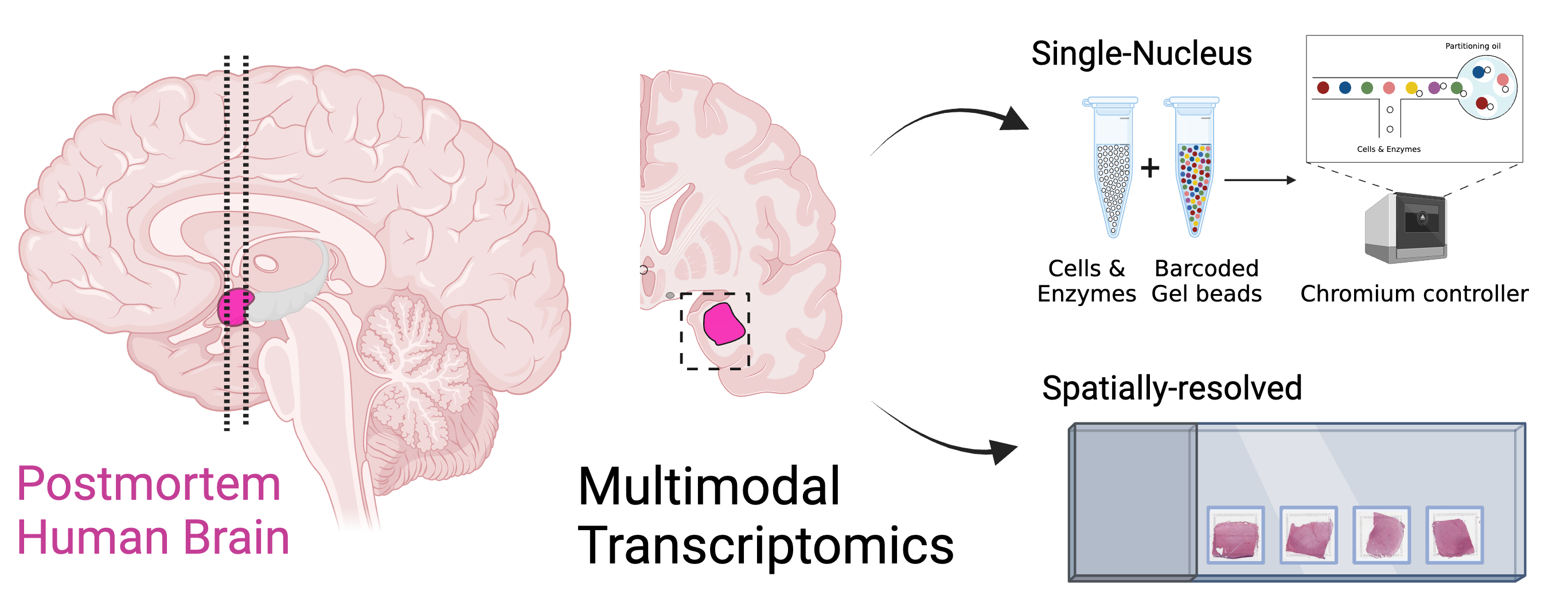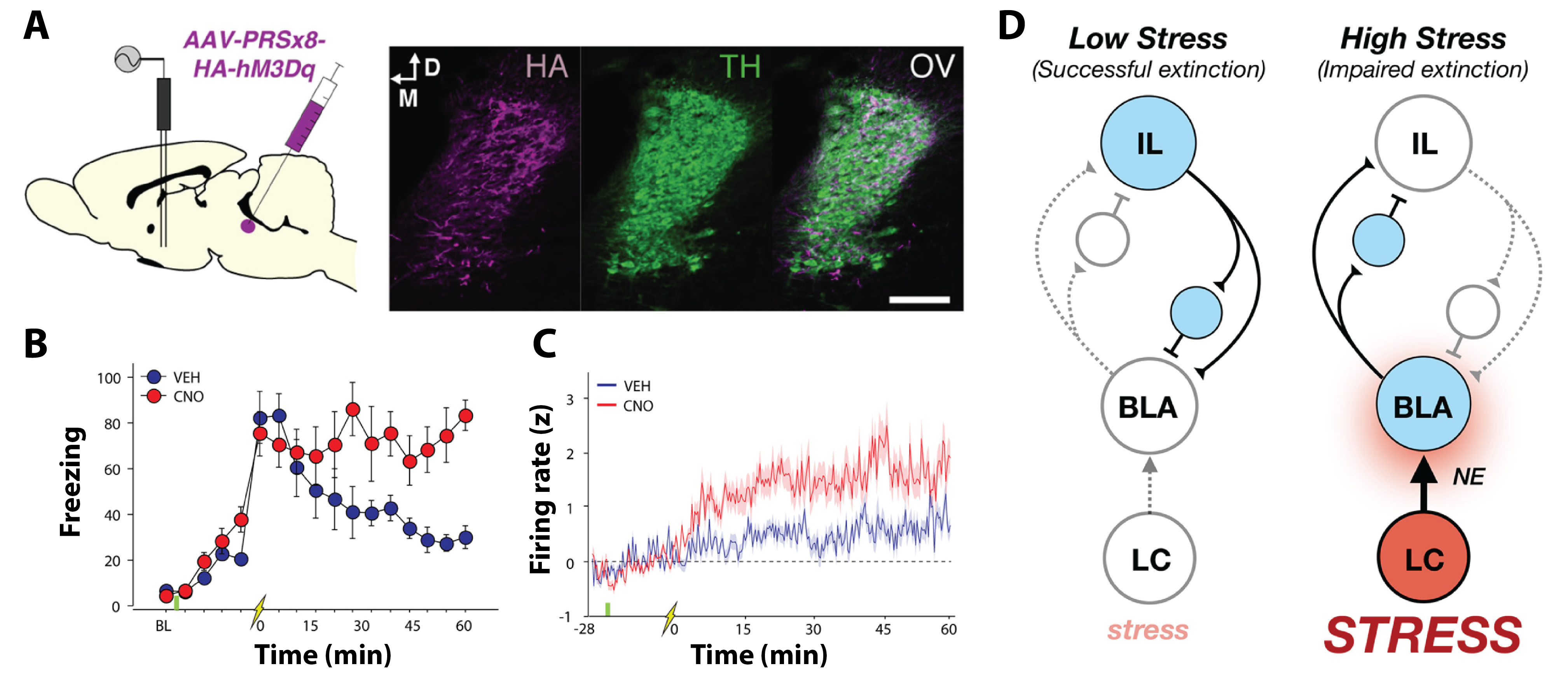Projects
Single-Cell and Spatial Transcriptomic Brain Mapping Across Species

This work aims to unravel the complex molecular landscapes of the human brain through cutting-edge transcriptomic approaches. This work involves creating detailed maps of the human postmortem brain with single-cell and spatial resolution, offering an unprecedented view of the cellular architecture that underlies human cognition and behavior. By conducting cross-species comparisons that span rodents, non-human primates, and humans, this research will bridge the gap between animal models and human biology. Looking ahead, this foundation will pave the way for future investigations into how these molecular landscapes change in psychiatric disease. These efforts are poised to reveal new insights into the biological underpinnings of mental health and disease, ultimately guiding the development of more effective therapies.
Key Publications:
Shah K, Totty MS, Bach SV, Valentine M, Chandra A, Divecha HR, Miller R, Kwon SH, Ramnauth A, Tippani M, Tyagi S, Kleinman JE, Collado-Torres L, Han S, Hyde TM, Page SC, Maynard KR, Hicks SC, Martinowich K. “Spatio-molecular gene expression reflects dorsal anterior cingulate cortex structure and function in the human brain.” bioRxiv. DOI: 10.1101/2025.07.14.664821.
Totty MS#, Cervera-Juanes#, R., Bach, S.V.#, Ben Ameur, L., Valentine, M.R., Simons, E., Romac, M.D., Trinh, H., Henderson, K., Del Rosario, I., et al. “Transcriptomic diversity of amygdalar subdivisions across humans and nonhuman primates.” Science Advances. DOI: 10.1126/sciadv.adw1029.
Totty MS, Hicks S, Guo B (2024). “SpotSweeper: spatially-aware quality control for spatial transcriptomics.” Nature Methods. DOI: 10.1101/2024.06.06.597765.
Neural Circuits and Mechanisms of Fear Extinction

Fear extinction is an inhibitory learning process by which humans and rodents alike learn to suppress fear to previously threatening stimuli. My research investigates the neural circuits that mediate this fundamental process. Using sophisticated techniques such as in vivo electrophysiology and optogenetics, my previous work discovered that the thalamic nucleus reuniens plays a critical role in synchronizing prefrontal and hippocampal theta oscillations, which ultimately acts to suppress fearful memories. This work is crucial for understanding the basic brain mechanism mediating fear suppression and has implications for treating anxiety disorders like PTSD.
Key Publications:
- Tuna T#, Totty MS#, Badarnee M, Mourao M, Peters S, Milad M (2025). “Associative coding of conditioned fear in the thalamic reuniens in rodents and humans.” Communications Biology DOI: 10.1101/2025.03.18.643915
- Totty MS, Tuna T, Ramanathan K, Jin J, Peters S, and Maren S (2023). “Thalamic nucleus reuniens coordinates prefrontal-hippocampal synchrony to suppress extinguished fear.” Nature Communications. DOI: 10.1038/s41467-023-42315-1.
- Liu J#, Totty MS#, Melissari L, Bayer H, Maren S (2022). “Convergent coding of recent and remote fear memory in the basolateral amygdala.” Biological Psychiatry. DOI: 10.1016/j.biopsych.2021.12.018.
Behavioral Models Relevant for Psychiatric Disease

Uncovering how core mechanisms of fear extinction is impacted due to stress is essential for advancing our understanding of psychiatric diseases. To do this, we investigate the stress and stress-related neurotransmitters, such as norepinphrine, impact neural circuitry critical to fear regulation. By focusing on the amygdala and related brain regions, I aim to mimic the pathological conditions seen in human psychiatric disorders, such as PTSD and generalized anxiety disorders. These models are critical for testing new therapeutic interventions and understanding the long-term effects of stress and other factors on mental health.
Key Publications:
- Totty MS, Warren N, Huddleston I*, Ramanathan K, Ressler R, Oleksiak C, Maren S (2021). “Behavioral and brain mechanisms mediating conditioned flight behavior in rats.” Scientific Reports. DOI: 10.1038/s41598-021-87559-3.
- Giustino TF, Ramanathan KR, Totty MS, Miles OM, and Maren S (2020). “Locus coeruleus norepinephrine drives stress-induced increases in basolateral amygdala firing and impairs extinction learning.” Journal of Neuroscience. DOI: 10.1523/JNEUROSCI.1092-19.2019.
- Totty MS, Payne M, Maren S (2019). “Event boundaries do not cause the immediate extinction deficit after Pavlovian fear conditioning in rats.” Scientific Reports. DOI: 10.1038/s41598-019-46010-4.